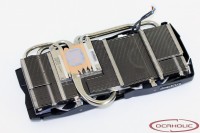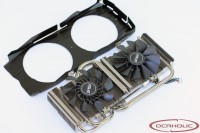ASUS GeForce GTX 780 Ti DirectCU II OC Review
Published by Christian Ney on 07.01.14Page:
The card
ASUS decided to equip the GeForce GTX 780 Ti DirectCU II OC with the latest revision of their famous DirectCU II cooler. It is exactly the same ASUS put on the GeForce GTX 780 DirectCU II series, no changes have been made. In this case you get no less than five heatpipes, two have a diameter of six millimeter, two eight millimeter and one features a massive ten millimeter. The heatpipes have been nickel plated and are in direct contact with the GPU core. Soldered to the heatpipes you find the fin stack which is being provided with fresh air via two 95mm fans. The fan closer to the I/O shield is a hybrid axial/radial fan ASUS like to call "CoolTech". They claim that this fan is able to provide a higher airflow than standard axial or radial fans at the same noise level. In case of the second fan you find a standard axial fan. Both fans are being manufactured by Everflow and strangely share the same model name, T129215SU.
Overall the cooler is well made and finished. Good thermal paste has been spread all over the core in large quantity and memory chips aren't actively cooled.
Like most of ASUS' recent high-end cards the PCB has been completely reworked and the power design beefed-up. A closer look at it shows a 10 phase power implementation for the main power design where the GPU gets eight (there are six on the reference card) and the memory two. The PCB design is looking very much alike the one you get with the GTX 780 DirectCU II.
The main power design MOSFETs are being actively cooled via an aluminium heatsink/thermal pad combo. The manufacturer decided to equip its GTX 780 Ti DC2OC with both metal reinforcement (located at the top end of the card) and full backplate to prevent bending and protect the card at the same time. The PCB is slightly oversized to allow easier access to SLI connectors. In the end the PCB is 3cm higher than the standard size.
Component wise ASUS makes use of high quality, so called Super Alloy Power, components. Last but not least, located at the rear of the PCB there are several voltage reading and modification points but unfortunately they are not labelled.
Checking the voltage regulation chip we find a digital multi-phase controller labelled Digi+ ASP1212 for the GPU, probably a rebranded CHiL 8228 or 8318, and one unidentified Richtek 2-phase controller labelled 02=FE A1B for the memory.
The memory chips on the GTX 780 Ti GHz come from SK Hynix and carry the model number H5GQ2H24AFR-R2C. They are specified to run at 1'750 MHz (7'000 MHz effective).
| Navigate through the articles | |
 Gigabyte GeForce GTX 780 Ti GHz Edition Review
Gigabyte GeForce GTX 780 Ti GHz Edition Review |
ASUS GeForce GTX 780 Poseidon Platinum (air) Review
 |
|
|










